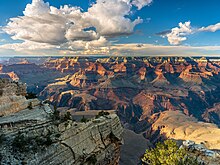
The 1990s saw the longest recorded economic expansion in American history, a dramatic decline in U.S. crime rates, and advances in technology. Throughout this decade, technological innovations such as the World Wide Web, the evolution of the Pentium microprocessor in accordance with Moore's law, rechargeable lithium-ion batteries, the first gene therapy trial, and cloning either emerged in the U.S. or were improved upon there. The Human Genome Project was formally launched in 1990, while Nasdaq became the first stock market in the United States to trade online in 1998.[167]
In the Gulf War of 1991, an American-led international coalition of states expelled an Iraqi invasion force that had occupied neighboring Kuwait.[168] The September 11 attacks on the United States in 2001 by the pan-Islamist militant organization al-Qaeda led to the war on terror, and subsequent military interventions in Afghanistan and Iraq.[169][170]
The U.S. housing bubble culminated in 2007 with the Great Recession, the largest economic contraction since the Great Depression.[171] Coming to a head in the 2010s, political polarization in the country increased between liberal and conservative factions.[172][173][174] This polarization was capitalized upon in the January 2021 Capitol attack,[175] when a mob of insurrectionists[176] entered the U.S. Capitol and sought to prevent the peaceful transfer of power[177] in an attempted self-coup d'état.[178] In May-August 2021, the 2021 Taliban offensive ended the War in Afghanistan one year after the United States–Taliban deal.[179]
Geography

The United States is the world's third-largest country by total area behind Russia and Canada.[d][180][181] The 48 contiguous states and the District of Columbia occupy a combined area of 3,119,885 square miles (8,080,470 km2).[10][182][183] The coastal plain of the Atlantic seaboard gives way to inland forests and rolling hills in the Piedmont plateau region.[184]
The Appalachian Mountains and the Adirondack massif separate the East Coast from the Great Lakes and the grasslands of the Midwest.[185] The Mississippi River System, the world's fourth-longest river system, runs predominantly north–south through the heart of the country. The flat and fertile prairie of the Great Plains stretches to the west, interrupted by a highland region in the southeast.[185]

The Rocky Mountains, west of the Great Plains, extend north to south across the country, peaking at over 14,000 feet (4,300 m) in Colorado.[186] Farther west are the rocky Great Basin and Chihuahua, Sonoran, and Mojave deserts.[187] In the northwest corner of Arizona, carved by the Colorado River over millions of years, is the Grand Canyon, a steep-sided canyon and popular tourist destination known for its overwhelming visual size and intricate, colorful landscape.
The Sierra Nevada and Cascade mountain ranges run close to the Pacific coast. The lowest and highest points in the contiguous United States are in the State of California,[188] about 84 miles (135 km) apart.[189] At an elevation of 20,310 feet (6,190.5 m), Alaska's Denali is the highest peak in the country and continent.[190] Active volcanoes are common throughout Alaska's Alexander and Aleutian Islands, and Hawaii consists of volcanic islands. The supervolcano underlying Yellowstone National Park in the Rocky Mountains, the Yellowstone Caldera, is the continent's largest volcanic feature.[191] In 2021, the United States had 8% of global permanent meadows and pastures and 10% of cropland.[192]
Climate

With its large size and geographic variety, the United States includes most climate types. East of the 100th meridian, the climate ranges from humid continental in the north to humid subtropical in the south.[193] The western Great Plains are semi-arid.[194] Many mountainous areas of the American West have an alpine climate. The climate is arid in the Southwest, Mediterranean in coastal California, and oceanic in coastal Oregon, Washington, and southern Alaska. Most of Alaska is subarctic or polar. Hawaii, the southern tip of Florida and U.S. territories in the Caribbean and Pacific are tropical.[195]
States bordering the Gulf of Mexico are prone to hurricanes, and most of the world's tornadoes occur in the country, mainly in Tornado Alley.[196] Overall, the United States receives more high-impact extreme weather incidents than any other country.[197][198] Extreme weather became more frequent in the U.S. in the 21st century, with three times the number of reported heat waves as in the 1960s. In the American Southwest, droughts became more persistent and more severe.[199] The regions considered as the most attractive to the population are the most vulnerable.[200]
